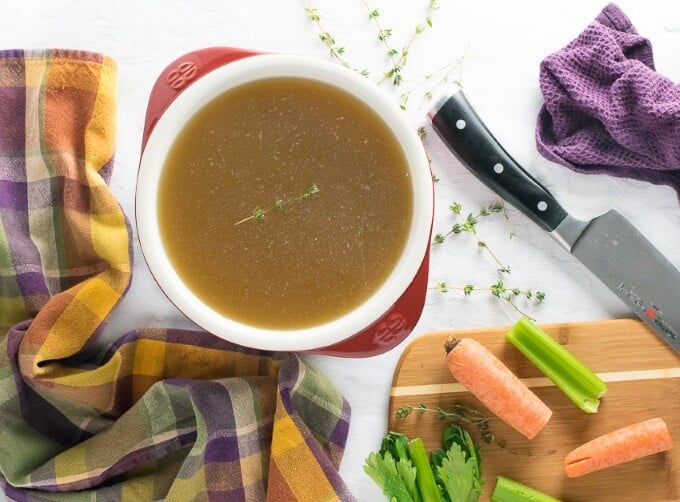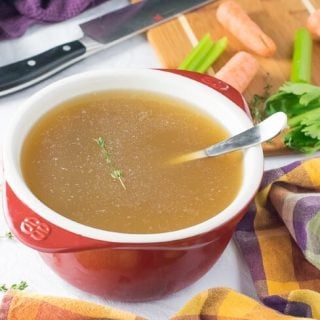Learning how to make homemade beef stock or beef broth is essential for anyone looking to create the best scratch-made soups you could ever hope to whip up in your kitchen.
Whether it is a holiday feast or roasted bones from a summer cookout, you’re likely left with a burgeoning belt-line, more leftovers than you could hope to eat in a month, and a messy kitchen showcasing the skeletal remains of the day’s main event. While most people would instinctively throw the remaining bones away without the slightest hesitation, you’re vowing to be different. This year you are going to make the best homemade stock ever!

Learning how to make your own stock and broth is a great way for anyone to get the most mileage out of their meat. Homemade stocks are the foundation of the greatest scratch-made soups you could ever hope to whip up in your kitchen. Sure, you can purchase stock and broth in a can at most grocery stores, but it will never match the flavor of a rich stock or broth slowly simmered with fresh herbs, vegetables, roasted bones, and meat. It rings true your new calling: Waste not, want not.
Broth vs Stock
The main difference between beef broth and stock is the inclusion of beef bones. Both are typically slowly simmered in a pot of water filled with aromatic herbs and vegetables. However, beef stock will include roasted beef bones, which release gelatin that thickens the final stock and provides a richer flavor. Beef broth on the other hand does not use bones and relies on meat to add body and flavor to the liquid.
Types of Homemade Stock
You can make homemade stock with any type of meat you wish, though beef stock and chicken stock are most popular. However, after Thanksgiving turkey stocks are cooked up by many savvy home cooks looking to make a tantalizing turkey soup with the holiday leftovers. In reality, you can make a flavorful stock with any meat you eat, including seafood.
The two basic types of stocks are brown stocks and white stocks.
- Brown stocks are the most common stocks. Its flavor profile is largely derived from roasting bones prior to simmering. Tomato paste is often used since it helps break down cartilage as well as impart additional flavor and color. When making the best beef stock, veal bones are ideal since they contain the most cartilage. However, any type of beef bones will suffice.
- White stocks are simmered the same way brown stocks are, but rather than roasting the bones, the soup bones are blanched. Blanching helps rid the bones of impurities that can cloud the stock.
To make an easy white stock you can add the bones and the vegetables to the water at the same time and just start making the stock. This will yield a fine stock, however, a true white stock will have the bones blanched in water that is then drained. The bones are then rinsed off, added to a new pot of water with the remaining vegetables and herbs and the stock is then made.
Homemade Stock & Broth Ingredients
The ingredients used in stocks can vary depending on personal taste. However, there are some basic ingredients found in most stocks:
- Leftover bones - Marrow bones are only used when making stock. If possible, break the soup bones in two, this helps create a more gelatinous stock. Roasting the meaty bones prior to making your stock is optional, but will and a deeper flavor.
- Meat - Meat is an important ingredient when making beef broth. Any beef scraps are fine to use. In particular, raw beef stew meat or leftover steak bites are great for making your own broth. When making stock, the meat is often still partially attached to some of the bones used in stock and can impart additional flavor.
- Tomato Paste - Only used in a brown stock. It adds flavor, color, and helps break down the cartilage.
- Water - It is the foundation of the stock's liquid. Add enough water to cover the ingredients by one - two inches.
- Carrots, Onions, and Celery - This is referred to as a mirepoix in French cooking or "The Holy Trinity" in Creole cuisine. These are the three most common vegetables found in stocks.
- Garlic - Fresh garlic cloves are typically added for their robust earthy flavor.
- Leeks - I don't view these as a necessity, but if I have them on hand they are a good addition to most stocks.
- Herbs - Bay leaves, thyme, and parsley are commonly used in stocks. However, additional herbs can be added per the cook's taste. For example, I add a little rosemary and sage when making my stock. Fresh herbs will provide a far better flavor than dried herbs.
- Seasoning - Peppercorns are a recommended addition, but I typically don't add other seasonings, including salt. I like making my stocks and broth salt free so I have greater flexibility to salt my final dish as I intend.
How to Make Homemade Stock or Broth
After deciding what type of meat you will be using for your stock or broth, and choosing between the white and brown stock, it is time to grab your large stock pot and get your ingredients simmering.
You will want to start with cold water, as it helps the stock stay clear. Place all of the stock or broth ingredients in the pot and add enough water to cover all of the ingredients by one to two inches. Once it has been heated, don’t allow it to boil as that will cause the fat to emulsify into the water. Instead, try to maintain a simmer between 185-205 degrees.
As the water evaporates, add more water as needed. There is no reason to stir the stock, but you will want to skim off the scum from the top of the stock as it gathers.
Stocks and broth are simmered for four to six hours on average. The long cooking time allows the stock to absorb all of the flavor from the ingredients. They are done when there is essentially no flavor left to absorb.

How to Store it
Once the broth or stock has finished simmering it needs to be cooled down prior to storing. First, pour the liquid through a fine-mesh strainer to separate the bones, meat, and vegetables from the hot liquid, or use a slotted spoon. Discard bones and all solid ingredients.
If you simply place your hot stock in a large covered container and set it in the refrigerator, you are asking for bacteria to sour the stock and make you sick. Large batches of soups and stocks need to be cooled from 140 degrees to 40 degrees in four hours or less.
Evaporating a little extra water from the stock and then adding ice cubes is a good way to cool the stock. Otherwise, divide the stock into smaller batches while cooling. Utilizing your freezer or, if you live up north, do what I do: Place the pot in a snow bank outside your door! The broth and stock both freeze very well for long-term storage, and can be frozen for up to three months in bagged ice cube trays or any other appropriate freezer containers. If left refrigerated, please store in an airtight container and use in less than a week.
Regardless of which method you choose, I do recommend having a reliable kitchen thermometer on hand so you are not leaving your food safety up to chance. I use this Digital Thermometer and love it. It is fast, accurate, and reliable.
How to use Stocks and Broth
Your homemade broth will stay in liquid form and can be measured out to be used in your slow cooker or soup pot as needed. However, beef stock becomes gelatinous as it cools, which makes it harder to measure. Microwaving the stock for a minute or two will return it to liquid form, making it much easier to work with. Although, you can still use it in its jelly form as well.
To avoid issues with measuring, I find it most convenient to store stocks and broth in one-cup increments so I can just grab what I need at the time.
You can use your beef stock and broth interchangeably in any recipe that calls for either. Particularly, to add rich flavor to your favorite soups and stews. You will likely notice a vastly improved flavor over the store-bought stocks and broths, as well as much less sodium.

How to Make Homemade Beef Stock or Broth
Equipment
- Large pot or Dutch Oven
Ingredients
- 4 pounds beef bones & meat *
- 4 ounces tomato paste
- 2 yellow onions quartered
- 2 celery ribs chopped
- 3 carrots peeled and chopped
- 2 leeks white parts only, trimmed and chopped
- 4 cloves garlic lightly crushed
- 2 bay leaves
- 5 sprigs fresh thyme
- 12 peppercorns
- ~1 gallon cold water ensure additions stay covered by 1”
Instructions
- Preheat the oven to 400 degrees F.
- Stock: Place the bones in a Dutch oven (or on a roasting pan) and roast for 1 hour, stirring to brown evenly. Remove from the oven and brush with the tomato paste. Lay the vegetables over the bones. Return to the oven and roast for 30 minutes.
- Broth: Place meat in a Dutch oven and brush with tomato paste then lay the vegetables over the meat. Place in the oven for 30 minutes.
- Place the Dutch oven on the stove top and deglaze with water, scraping the brown bits off the bottom of the pot into the liquid. Add the peppercorns, garlic, water, and herbs. Bring the liquid up to a boil and reduce to a simmer.
- Gently simmer over low heat for 4-6 hours uncovered, removing any foam/scum/fat that rises to the surface.
- Remove from heat and ladle the ingredients in batches into a strainer set over a pot or large bowl. Gently press the solids with the ladle to extract all the liquid. Discard all solids in the strainer and place the liquid in your freezer or refrigerator to cool.
- Lift off any excess fat once cooled.
Notes
Nutritional Information
This recipe was originally published on FoxValleyFoodie.com on November 26, 2015.



Tim
I like using my pressure cooker , saves time and energy.